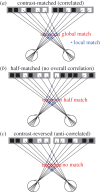Weighted parallel contributions of binocular correlation and match signals to conscious perception of depth
- PMID: 27269600
- PMCID: PMC4901451
- DOI: 10.1098/rstb.2015.0257
Weighted parallel contributions of binocular correlation and match signals to conscious perception of depth
Abstract
Binocular disparity is detected in the primary visual cortex by a process similar to calculation of local cross-correlation between left and right retinal images. As a consequence, correlation-based neural signals convey information about false disparities as well as the true disparity. The false responses in the initial disparity detectors are eliminated at later stages in order to encode only disparities of the features correctly matched between the two eyes. For a simple stimulus configuration, a feed-forward nonlinear process can transform the correlation signal into the match signal. For human observers, depth judgement is determined by a weighted sum of the correlation and match signals rather than depending solely on the latter. The relative weight changes with spatial and temporal parameters of the stimuli, allowing adaptive recruitment of the two computations under different visual circumstances. A full transformation from correlation-based to match-based representation occurs at the neuronal population level in cortical area V4 and manifests in single-neuron responses of inferior temporal and posterior parietal cortices. Neurons in area V5/MT represent disparity in a manner intermediate between the correlation and match signals. We propose that the correlation and match signals in these areas contribute to depth perception in a weighted, parallel manner.This article is part of the themed issue 'Vision in our three-dimensional world'.
Keywords: binocular disparity; correspondence problem; random-dot stereogram; reversed depth perception; stereopsis; three-dimensional perception.
© 2016 The Author(s).
Figures






Similar articles
-
Responses of primary visual cortical neurons to binocular disparity without depth perception.Nature. 1997 Sep 18;389(6648):280-3. doi: 10.1038/38487. Nature. 1997. PMID: 9305841
-
A Single Mechanism Can Account for Human Perception of Depth in Mixed Correlation Random Dot Stereograms.PLoS Comput Biol. 2016 May 19;12(5):e1004906. doi: 10.1371/journal.pcbi.1004906. eCollection 2016 May. PLoS Comput Biol. 2016. PMID: 27196696 Free PMC article.
-
Disparity processing in primary visual cortex.Philos Trans R Soc Lond B Biol Sci. 2016 Jun 19;371(1697):20150255. doi: 10.1098/rstb.2015.0255. Philos Trans R Soc Lond B Biol Sci. 2016. PMID: 27269598 Free PMC article. Review.
-
Temporal channels and disparity representations in stereoscopic depth perception.J Vis. 2013 Nov 26;13(13):26. doi: 10.1167/13.13.26. J Vis. 2013. PMID: 24281242
-
The physiology of stereopsis.Annu Rev Neurosci. 2001;24:203-38. doi: 10.1146/annurev.neuro.24.1.203. Annu Rev Neurosci. 2001. PMID: 11283310 Review.
Cited by
-
Vision in our three-dimensional world.Philos Trans R Soc Lond B Biol Sci. 2016 Jun 19;371(1697):20150251. doi: 10.1098/rstb.2015.0251. Philos Trans R Soc Lond B Biol Sci. 2016. PMID: 27269595 Free PMC article.
-
Microstructural properties of the vertical occipital fasciculus explain the variability in human stereoacuity.Proc Natl Acad Sci U S A. 2018 Nov 27;115(48):12289-12294. doi: 10.1073/pnas.1804741115. Epub 2018 Nov 14. Proc Natl Acad Sci U S A. 2018. PMID: 30429321 Free PMC article.
-
Specialized contributions of mid-tier stages of dorsal and ventral pathways to stereoscopic processing in macaque.Elife. 2021 Feb 24;10:e58749. doi: 10.7554/eLife.58749. Elife. 2021. PMID: 33625356 Free PMC article.
-
Human and artificial visual systems share a computational principle for transforming binocular disparity into depth representation.Commun Biol. 2025 Jul 11;8(1):1042. doi: 10.1038/s42003-025-08474-1. Commun Biol. 2025. PMID: 40646303 Free PMC article.
References
-
- Wheatstone C. 1838. Contributions to the physiology of vision—part the first. On some remarkable, and hitherto unobserved, phenomena of binocular vision. Phil. Trans. R. Soc. Lond 128, 371–394. (10.1098/rstl.1838.0019) - DOI
-
- Howard IP. 2002. Seeing in depth: vol. 1. Basic mechanisms. Toronto, Canada: I Porteous.
-
- Howard IP, Rogers BJ. 2002. Seeing in depth: vol. 2. Depth perception. Toronto, Canada: I Porteous.
Publication types
MeSH terms
LinkOut - more resources
Full Text Sources
Other Literature Sources
Research Materials

